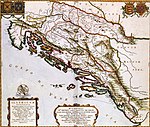This article needs additional citations for verification. (September 2021) |
| Sanjak of Bosnia | |||||||||||
|---|---|---|---|---|---|---|---|---|---|---|---|
| Sanjak of the Ottoman Empire | |||||||||||
| 1463–1878 | |||||||||||
 Map of the Sanjak of Bosnia at its height. | |||||||||||
| Demonym | Bosnian | ||||||||||
| History | |||||||||||
| 1463 | |||||||||||
• Eyalet of Bosnia established | 1580 | ||||||||||
| 1878 | |||||||||||
| |||||||||||
| Today part of | |||||||||||
Sanjak of Bosnia (Turkish: Bosna Sancağı, Serbo-Croatian: Bosanski sandžak / Босански санџак) was one of the sanjaks of the Ottoman Empire established in 1463 when the lands conquered from the Bosnian Kingdom were transformed into a sanjak and Isa-Beg Isaković was appointed its first sanjakbey.[1] In the period between 1463 and 1580 it was part of the Rumelia Eyalet. After the Bosnia Eyalet was established in 1580 the Bosnian Sanjak became its central province.[2] Between 1864 and the Austro-Hungarian occupation of Bosnia in 1878 it was part of the Bosnia Vilayet that succeeded the Eyalet of Bosnia following administrative reforms in 1864 known as the "Vilayet Law". Although Bosnia Vilayet was officially still part of the Ottoman Empire until 1908 the Bosnian Sanjak de facto ceased to exist in 1878; when it was occupied by Austria-Hungary.
Banja Luka became the seat of the Sanjak of Bosnia some time prior to 1554, until 1580 when the Bosnia Eyalet was established. Bosnian beylerbeys were seated in Banja Luka until 1639.[3]
Demographics
[edit]
Apostolic visitor Peter Masarechi claimed in his 1624 report that the population of Bosnia was 450,000 Muslims, 150,000 Catholics, and 75,000 Orthodox.[4]
Administration
[edit]List of sanjakbeys of Bosnian Sanjak is the following:[citation needed]
- Minnetoğlu Mehmed Bey, 1464
- Isa-beg Isaković, 7 February 1464–1470
- Ajaz-beg, 1470–1474
- Sinan-beg, 1474
- Arnaut Davud-beg, 1474–1475
- Bali-beg Malkočević (Turkish: Bali Bey Malkoçoğlu), 1475–1477[citation needed]
- Ajaz-beg, 1477–1478
- Skender Pasha, 1478–1479
- Arnaut Davud-beg, 1479–1480
- Skender Pasha, 1480–1482
- Jahja-beg, 1482–1483
- Ajaz-beg, 1483–1484
- Mehmed-beg Ishaković, 1484–1485
- Sinan-beg, 1485–1490
- Hadum Jakub-paša, 1490–1493
- Jahja Pasha, 1493–1495
- Firuz Bey, 1495–1496[5]
- Skender-paša Mihajlović, 1498–1505
- Firuz Bey, 1505–1512
- Hadum Sinan-beg Borovinić, 1512–1513
- Junuz-beg, 1513 – 14 April 1515
- Mustafa-paša Jurišević (Mustafa-paša Skenderpašić), 14 October 1515 – 17 April 1516
- Gazi Hasan-beg, 17 April 1516 – 1517
- Gazi Mehmed-beg Mihajlović (Turkish: Gazi Mehmed Bey Mihalzade), 1517–1519
- Gazi Bali-beg Jahjapašić, 1519 – 15 September 1521
- Gazi Husrev-beg, 15 September 1521 – 1525
- Gazi Hasan-beg, 1525–1526
- Gazi Husrev-beg, 1526–1534
- Ulama-paša, 1534–1536
- Gazi Husrev-beg, 1536 – 18 June 1541
- Ulama-paša, 18 June 1541 – 1547
- Sofi Ali-beg, 1547–1549
- Muhamed-han Zulkadrić (Turkish: Muhamed Han Zulkadrioğlu), 1549–1550
- Hadim Ali-beg 1550–1551
- Sofi Mehmed-paša, 1551–1553
- Hadim Gazi Ali-paša, 1553
- Dugali Malkoč-beg, 1553–1554
- Kara Osman-han, 1554–1555
- Kara Mustafa-beg Sokolović, 1555–1557
- Hamza-beg Biharović, 1557–1561
- Hasan-beg Sokolović, 1561–1562
- Sinan-beg Boljanić, 1562–1564
- Mustafa-beg Sokolović, 1564–1566 [6]
- Mehmed-beg Sokolović, 1566–1568[7]
- Ferhad-beg Desisalić, 1568 – 25 June 1568
- Mehmed-beg Sokolović, 25 June 1568 – 1574[8]
- Ferhad-beg Sokolović (Turkish: Ferhad Bey Sokollu), 1574–1580[9]
See also
[edit]| History of Bosnia and Herzegovina |
|---|
 |
|
|
- List of Ottoman governors of Bosnia
- Ottoman Bosnia and Herzegovina
- Pashaluk of Herzegovina
- Sanjak of Novi Pazar
References
[edit]- ^ Enciclopedia Croatica (in Croatian) (III ed.). Zagreb: Naklada Hrvatskog izdavalačkog bibliografskog zavoda. 1942. p. 157. Archived from the original on 2011-12-05. Retrieved March 15, 2011.
Krajišnik Isabeg imenovan je 1463 sandžakbegom novoustrojenog sandžaka Bosna
- ^ Omer Ibrahimagić (1998). Constitutional development of Bosnia and Herzegovina. Vijeće Kongresa bošnjačkih intelektualaca. p. 78. ISBN 9789958470301. Retrieved 23 January 2013.
The former Bosnian sanjak became the central sanjak of this ayalet.
- ^ Hercegovine, Društvo istoričara Bosne i (1952). Godišnjak: Annuaire (in Serbian).
- ^ Mitja Velikonja (2003). Religious Separation and Political Intolerance in Bosnia-Herzegovina. Texas A&M University Press. pp. 56–. ISBN 978-1-60344-724-9.
- ^ Sarajevu 2007, p. 224.
- ^ Efendi, Nahifi Mehmed. (2019). Cevahiru'l-Menakib: Sokollu Mustafa Paşa'nın Hayatı. T. C. Türkiye Yazma Eserler Kurumu Başkanlığı. ISBN 978-975-17-4249-0
- ^ Dakic, Uros. (2012). The Sokollu Family Clan and the Politics of Vizierial Households in the Second Half of the Sixteenth Century. (MA Thesis). Department of Medieval Studies, Central European University.
- ^ Dakic, Uros. (2012). The Sokollu Family Clan and the Politics of Vizierial Households in the Second Half of the Sixteenth Century. (MA Thesis). Department of Medieval Studies, Central European University.
- ^ Dakic, Uros. (2012). The Sokollu Family Clan and the Politics of Vizierial Households in the Second Half of the Sixteenth Century. (MA Thesis). Department of Medieval Studies, Central European University.
Sources
[edit]- Sarajevu, Gazi Husrevbegova biblioteka u (2007). Anali Gazi Husrev-begove biblioteke. Gazi Husrev-begova biblioteka.
